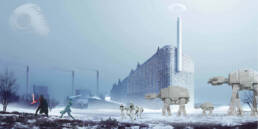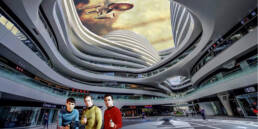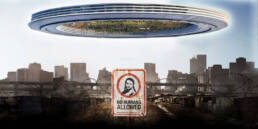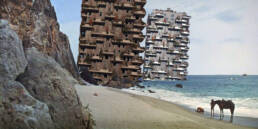Image credits: Photomontage designed by N.V.Canessa, Modulor (Le Corbusier) on Moon Footprint
A part of the world we have built in the last fifty years takes our hands full of the imagery of space travel and sci-fi culture. Creating the paradox of seeing devices made that look like those we have already seen in films or, as in reality, almost always happens, we see in science fiction films something that we already use on a daily basis or that is already available on the market, possibly a bit “augmented.”
This is true for the objects, partly for the clothes even if the work of the costume designers is often of great level and does not use something already existing, but also and perhaps above all, until the introduction of digital, the settings.
To set them it was necessary to use real places, buildings and landscapes, then playing with lights, special effects and framing cuts to make it seem distant – in space or time – something that instead did not have much science fiction, but that entered into our imagination as such.
Very often the portrait we make of the cities of the future takes its cue from our real world, from the cities in which we live every day. Our ideas about the future of cities are born in the present, and even the wildest fantasies have their foundations in the metropolises we know. When we look at the city of the future, we are looking at our city.
In the city of the future imagined until the beginning of the last century, trains went like rockets on rails in the sky, planes in a dive from the sky landing on roofs, skyscrapers stretched up to the sky, just as today we fantasize – because what we have is still just a toy – about intelligent cities, vehicles and automated buildings, and screens put on anything. It’s with Metropolis, Fritz Lang’s very powerful film, that a turning point is generated in the understanding of science fiction, which began to show its less positive and more cautionary face.

What’s curious is that at this stage of the cinema, the hyper-realistic cities were painted models or backdrops and today, as then, to tell the present, we use render of an icy beauty that make us imagine an unreal world, even when certain buildings would work quietly as they will be built later.
Taking a few steps forward we find ourselves in the middle of the whole science fiction genre of the 1960s and 1970s in which, both for the race to space and for the fear of global nuclear war, there are two currents that hold particularly close: an expansion of man on the Moon and other planets and the post-apocalyptic tale, which will then explode after the first film dedicated to Mad Max in 1979.
It’s at this moment that the film world begins to use the real city to make it futuristic, in the moment in which the aliens are dressed as ancient romans – eg. Star Trek – and the post-apocalyptic is the ruined megalopolis or the boundless desert. For example, the 1982 film Blade Runner, set in a Los Angeles in 2019, uses the royal city a lot and some of its symbols become important places in the film such as the Bradbury Building, where Rick Deckard finally meets Roy Batty. The film is set in Los Angeles, although Philip K. Dick’s original book portrayed San Francisco, but director Ridley Scott initially thought of shooting it in Hong Kong, which would have been too expensive. But despite this, the aesthetics of Blade Runner undoubtedly evoke the twisted alleys of an overcrowded Hong Kong rather than the wide avenues of Los Angeles, and this puts us in a position to imagine a world gone wrong. Cyberpunk has an aesthetic that blends the western interpretation of extreme Asia as dark and overpopulated with the cowboy spirit of North America.

Today’s cities are already the backdrop for the cities of the future, and unfortunately when they are designed to resemble the future they appear much earlier linked to the past.
The total science fiction vision of the city of the future is a mosaic, built from fragments of the cities we recognize, including symbols clearly taken from the past that continue to be cornerstones of our present. The Statue of Liberty, for example, is a recurring element in science fiction films. One of his most famous appearances is in the 1968 film The Planet of the Apes. For both the protagonist and the spectators, it is a clue that the world of fiction is not an alien planet, but ours, only a few thousand years later, but it is also a warning of what has remained of that world, not intended as an iconic building structurally resistant, but as an object deprived by now of its meaning.
Of those buildings that will resist on the beach, will our posterity still be able to understand their meaning?
In the meantime, however, another idea of science fiction has slowly begun to make its way, a more minimalist current that has inevitably realized two things: that we are living the future and that the things we imagine are often distant, useless and unrealisable, like the infamous flying car.
It’s a journey that began in the late 1990s, just as Matrix was exploding the fashion for long leather coats. A process that began perhaps with Gattaca continued with Equilibrium. To the dirt of the metropolis of Blade Runner these films contrasted an aseptic civilization, to the limits of minimalism. It is no coincidence that these films are also dominated by total control in the style of Big Brother: the order of these places is the order imposed on those who live there, while in cyberpunk the case reigns supreme and order, which are the multinationals and the rich, are only concerned with living far from the poor. On the one hand we have totalitarianism, on the other capitalism.
The mixture between these two influences has given rise to the scenarios that today we see in Black Mirror, a series that is less and less science fiction and more and more documentary. Here the scenarios are almost never those of a dirty and suffocating urbanization, but often tend to the simple tones of an Ikea catalogue. These are places that speak of a humanity that has replaced Gibson’s cyberspace with social networks on phones.

In the end what is perhaps true is that to resemble the future we are building a world with buildings aesthetically beautiful and avant-garde, which give us the idea of a new ecology (dedicated to those who live them), but probably not a way for humans.
Nicola V. Canessa
PhD Architect and Adjunct Professor in “Laboratory of Urbanism” and in “Theory and urban innovation” in the Degree and Master in Architecture, Department DAD, University of Genoa (Italy).

